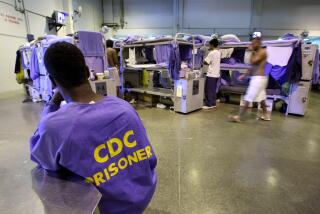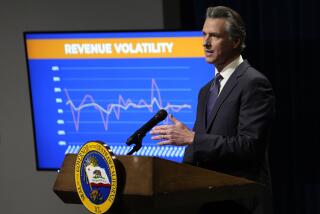Cost Result of Gann ‘Fair-Pay’ Initiative Termed ‘Unknown’
- Share via
Exactly how much money tax reformer Paul Gann’s “Fair Pay Amendment,” Proposition 61 on the Nov. 4 ballot, will save--or cost--taxpayers by setting limits on public officials’ income has emerged as the major issue in the campaign.
John Vickerman, the state’s acting legislative analyst, offered plenty of possibilities but no definitive answer to that question in ballot language released Tuesday by the office of Secretary of State March Fong Eu.
The net fiscal impact of the measure, Vickerman’s staff assessed, is “unknown.”
State and local government leaders, unanimously opposed to the measure, have predicted that its passage could prompt an exodus of top management and professional officials whose salary would be cut, and could bankrupt the state by forcing a one-time buy-out of all employees’ current unused vacation and sick leave.
80% of Governor’s Salary
The initiative would set the governor’s salary (now $49,500 and scheduled to rise to $85,000 in 1987) at $80,000 and limit most elected and appointed state and local government officials to 80% of that or $64,000. Constitutional officers--lieutenant governor, secretary of state, attorney general, treasurer and superintendent of public instruction--and members of the the Board of Equalization would get $52,000. Contracts for special services, such as outside work by private architects, would be limited to $75 an hour or a total of $64,000 a year.
The governor’s salary could be increased by a vote of the electorate, and certain salaries could be raised by a two-thirds vote of the Legislature deciding, for example, that a state-employed heart surgeon qualified for “special circumstances” warranting more than $64,000 a year.
The measure also prevents employees from carrying over unused vacation and sick leave from year to year.
In the proposed ballot analysis, Vickerman’s staff estimated that reductions in state salaries and benefits could save taxpayers $125 million, with perhaps a like amount saved in local government pay.
Gann himself, questioned repeatedly about how much his measure could save, has guessed slightly less--$100 million.
Vacation Time Payoff
But the ballot language warns that such savings might never be realized because of the provision allowing the Legislature to set “special circumstances” pay, and because non-salary benefits could be raised to keep government compensation packages competitive with private industry.
Local governments also could face “unknown” costs, the ballot language states, for substitute workers if employees predictably take all unused vacation and sick leave at the end of each year.
As for the key question of the cost of any one-time payoff of previously accrued leave, the legislative analyst’s office stated:
“This analysis assumes that the carry-over restrictions imposed on vacation and sick leave would not apply to unused leave time earned prior to the amendment’s effective date (Nov. 5, 1986).”
Atty. Gen. John K. Van de Kamp and other legal experts, however, have assumed the contrary--that the vacation time accrued prior to Nov. 5, 1986, could not be carried over, and employees would have to be paid in cash for leave already earned. Van de Kamp, in a report to a joint legislative committee, projected that cost to be $2.9 billion for the state, plus a like amount for local governments.
Gann has told audiences around the state that if he believed that were true--which he makes clear he does not--he would personally campaign against his own initiative.
Could Cost $7 Billion
Gann said the Legislature or the courts would have to decide about any one-time payoff and that he had never considered it when drafting the measure.
If the courts did decide the buy-out must be made, the legislative analyst’s office estimated in the proposed ballot language, the cost to state and local governments combined could be $7 billion.
The ballot language estimates that 9,000 state employees and an unknown number of local employees would face salary cuts under the initiative. The California State Personnel Board has placed that figure as high as 18,000 state employees alone. Gann says that only 7,000 total government employees would be affected.
The legislative analyst’s office said that those affected would include top level managers including city police and fire chiefs, medical personnel, legal personnel including all judges and top level prosecutors, and University of California senior professors and administrators.
The proposed ballot language will remain open to public inspection for 20 days, with any challenges to be lodged in Sacramento Superior Court. Printing is scheduled for Aug. 11.
More to Read
Get the L.A. Times Politics newsletter
Deeply reported insights into legislation, politics and policy from Sacramento, Washington and beyond. In your inbox twice per week.
You may occasionally receive promotional content from the Los Angeles Times.










